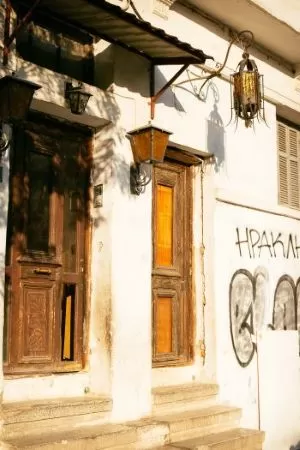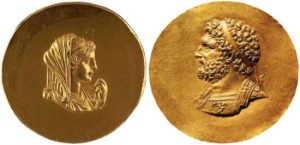


We often cross the streets of the city, the names of which we know, but without thinking about the relationship of these names to the city, when it was made and what the choice of this naming signifies. With the incorporation of the former Ottoman city into the Greek state in 1912, the redrawing of streets with the Hébrard Plan after the fire that took place in 1917 and a little later the final withdrawal of the Muslim element with the Treaty of Lausanne of 1923, the city’s streets, in their majority, acquire names connected to the Greek element. Among the others, names of the members of the glorious Macedonian dynasty are chosen, of which Thessaloniki herself was a member, daughter of Philip II and half-sister of Alexander the Great.
The name of the glorious soldier was successively borne by the predecessor of today’s Katouni street, today’s Tsimiski, the coastal Nikis Avenue and finally the extension of the latter further east, today Megalou Alexandrou Avenue. The name of Philip II, Alexander’s father, is borne by the street parallel to Egnatia just below the Roman Agora, while the name of his mother, the infamous Olympias, is preserved in the curved street that hugs the historic center as the lower limit of the Upper Town.
How many of us have thought that the name of the founder of the city has been given to a one-way street in one of the most densely built-up areas of the center, which barely has room for a car to pass between the permanent double-parked ones? And yet Kassandrou Street, the first parallel street above Agios Dimitrios, bears the name of the man who, in addition to the city of Kassandreia in Halkidiki (on the site of Potidea that was destroyed by Philip II), according to Strabo, founded the city of Thessaloniki in 316/ 315 BC, uniting the smaller towns of the region into an urban center by Thermaikos Gulf, giving it the name of his wife.
But who was Kassandros and what was his relationship with the royal family of Macedonia? Kassandros (Cassander) was the son of Antipater, an eminent general of Philip II, who, after the latter’s assassination at Aiges in 336 BC, was appointed regent and curator of the Kingdom of Macedonia, a position he retained throughout the campaign of Alexander the Great in Asia. Despite his successful rule, he came to a rupture with the queen mother Olympias. After the death of Alexander, Antipater proclaimed the experienced Polyperchon (without blood ties) as his successor in the regency of Macedonia, while he gave his young son the second place in the hierarchy. Cassander, feeling wronged, found allies, declared war against his competitors and finally managed to prevail in the so-called War of the Epigoni and dominate Macedonia.
Cassander was a sworn enemy of Olympias, who wanted to place on the throne her grandson Alexander IV, Alexander’s son by the Sogdian princess Roxani (Roxani was pregnant when Alexander died) on the throne. He allied himself with the mentally unstable son of Philip II and half-brother of Alexander Philip III Arridaeus and his ambitious wife Antiaia Eurydice, who declared Cassander to be the custodian of the throne. Olympias marched into Macedonia, defeated the royal couple and put them to death in a gruesome manner.

Gold medal depicting Queen Mother Olympias from Abukir, Egypt, Archaeological Museum of Thessaloniki – Gold medal from the treasury of Tarsus, Cabinet des Médailles, Paris.
Cassander immediately advanced against Olympias, who fled to the fortified Pydna with Roxani and little Alexander. After a seven-month siege (according to one version he handed her over to the crowd who stoned her and her corpse was left to rot). Her last wish was for Cassander to respect her grandson’s life, however, a few years later, in 310 BC, the young heir together with his mother were murdered in a horrible and torturous way by Cassander in Amphipolis. A year later, Alexander’s second son Herakles and his mother Varsini met the same fate, as they were murdered, again with Cassander’s involvement. In this way, the bloodline of Philip, Olympias and Alexander was ended and the Argead dynasty was extinguished.
But fate was not favorable for the Cassander dynasty either. He himself died of an illness in 297 BC, while according to Pausanias, his eldest son and successor Philip also died of an illness shortly after his enthronement. But for Thessaloniki helself, the reality was harsher than the myth of the mermaid tells, as she was murdered by her son Antipater II, the next in line, for the favor she showed to his younger brother Alexander V. The latter was finally killed a few years later by another great personality of the Hellenistic times, who played a decisive role in the war of Alexander’s Successors, Demetrius Poliorcetes (337 BC – 283 BC), the life and the action of whom constitute another separate story.
And yet, so many centuries later, the curved Olympiados street meets Kassandrou street at its ends, like a game of fate for the two spineless enemies. The two streets are intersected vertically by Dimitriou Poliorkitou Street, continuing higher in the Upper Town as an ironic reminder of life’s ups and downs, while Philippou Street, named after the man whose untimely death created all these chain reactions, is located several meters further south, seeming to take no part in the rivalry that led to the elimination of his generation.
Written by Vasilis Nanis